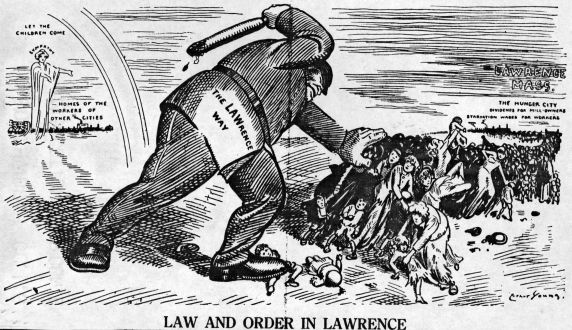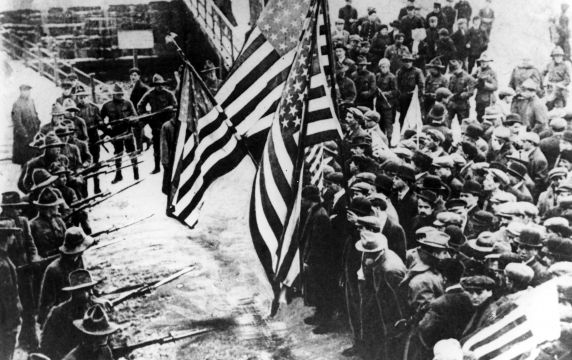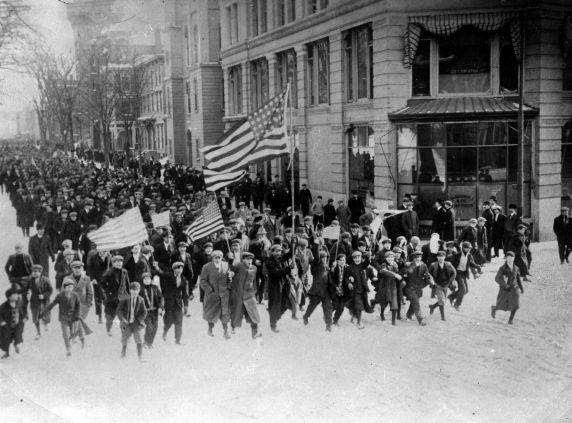The Lawrence Textile Strike
January 2012 marks the 100th anniversary of a watershed moment in American labor history: the Lawrence Textile Strike. Commonly referred to as the "Bread and Roses Strike," workers fought to not only earn enough to feed their families, but to also be afforded basic human dignity. For this reason, many consider the event’s significance as a social revolution to be equally as important as its impact on working conditions.
To understand the importance of the strike one must understand the conditions of the time. Lawrence, Massachusetts was an immigrant city, with the majority of its population being foreign born. Workers from Eastern Europe, the Middle East, Italy, Germany, Portugal and French Canada packed into Lawrence’s crowded slums. The average wage of $8.76 per week was consumed by housing costs, which were the highest on the East Coast. The life expectancy for workers and their families was among the worst in the nation. A study by a Lawrence physician, Dr. Elizabeth Shapleigh, determined that 36 out of 100 workers in the Lawrence mills died by the age of 25 and 50% of the children born to workers died before the age of six. Over 50% of the workers in the mills were women and children, working out of financial necessity.
On January 1, 1912 a new law in Massachusetts reduced the maximum hours a woman or child could work in a factory each week from 56 to 54. Ever looking to cut costs, textile mills throughout Lawrence made up for this lack in production by decreasing wages. The cuts were equal to several loaves of bread for most workers, which was devastating for families who were barely surviving on starvation wages. When the first reduced pay slips appeared on January 11, 1912, Polish women at the Everett Cotton Mills reportedly shouted “Short pay! Short pay!” and walked out of the mill in protest. By the end of the following day, dissension spread throughout Lawrence and over 20,000 workers walked off their jobs.
In the beginning the outcome of the strike was uncertain. The majority of the unskilled workers shared no common language, did not belong to a union and had little experience with strikes. Initially, mill owners were confident that the strike would fail since the American Federation of Labor (AFL), who represented the mostly white, English-speaking skilled craftsmen in Lawrence, refused support to a demonstration composed of women, children and the foreign born. The mood shifted when Joseph Ettor, a multi-lingual organizer with the radical Industrial Workers of the World (IWW) and Arturo Giovannitti, a poet and editor of the Italian socialist newspaper Il Proletario, were brought in to organize the workers.

The strikers had three simple demands: a 15% pay increase, a 54-hour work week and overtime pay at double the rate of normal pay. Working under the philosophy of non-violence, strikers peacefully picketed the mills, disrupted local businesses by staging brief sit-ins and lead massive demonstrations throughout the city streets. The local militia was called in to arrest strikers and force them back from the mills through physical and mental intimidation. Demonstrators were beaten and sprayed with fire hoses, a dangerous practice during the bitter winter months. Dynamite was planted in buildings used by the strikers in attempts to turn public opinion against them, purportedly at the request of William Wood, President of the American Woolen Company. The strikers remained undeterred. When the governor of Massachusetts called in the State Militia (National Guard) to break up the demonstrations, the result was the death of a 15-year old Syrian boy who was bayoneted during a clash with the strikers. On January 29, a woman named Anna LoPizzo was killed when police tried to break up a demonstration. Eager to be rid of the “ringleaders” of the strike, Ettor and Giovannitti were charged as accessories to murder, despite the fact that they were at meetings three miles away at the time of the incident. The two remained in jail until the conclusion of their trial in November of that year, when they were acquitted of all charges. In their absence, the IWW sent in their big guns: Elizabeth Gurley Flynn, Carlos Tresca, “Big Bill” Haywood and William Trautmann.
Conditions were undeniably difficult for most workers. Soup kitchens were organized throughout the city and a nationwide call for assistance brought in between $2 and $5 per worker family, along with clothing and medical care. Eventually conditions became unbearable enough that an evacuation of the workers’ children was staged. The evacuation was so successful in garnering public sympathy and support for the strike that when a later evacuation was underway on February 24, the militia intervened. Mothers and their children were beaten indiscriminately and 30 women were arrested.
This incident, which was widely reported in the media, was the turning point of the strike and resulted in congressional hearings into mill conditions. After hearing the testimony of workers from Lawrence, President William Taft ordered a nationwide investigation into industrial conditions. Rather than risk more bad publicity and further government intervention, the American Woolen Company, one of the largest mills in Lawrence, conceded to the strikers demands on March 12, 1912. By the end of the month, the other mills followed suit and the strike was over. Though most of the gains from the strike were offset by unemployment caused by machine speed-ups later in the year, the strike proved to disenfranchised workers that they had the power to challenge authority if they stood together in solidarity. Textile workers throughout the East Coast were emboldened to fight for their basic rights – a fight that would resurface the next year in the silk mills of New Jersey with the spectacular Patterson Strike.
The Reuther Library has numerous resources that document the events of the Lawrence Textile Strike. Within the IWW Records one will find, among other treasures, transcripts from the trials of Ettor and Giovannitti as well as a final report on the strike. For the IWW’s account of the strike as it happened, consult their newspaper Solidarity, which is available on microfilm for research use. For a look at the strike through the eyes of one of its organizers, the William E. Trautmann Papers provide a unique view of the events. The papers of the journalist and social critic Mary Heaton Vorse examine both the Lawrence Strike and the topic of child labor in the United States. An arresting, firsthand account of the evacuation of the children, conditions in Lawrence under Marshall Law and the leading personalities of the strike is found within Ms. Vorse’s memoir “A Footnote to Folly,” whose chapter on the Lawrence Strike originally appeared as an article in Harpers Weekly. Another perspective can be found in the papers of Matilda Robbins, a writer and organizer for the IWW from 1912 until her death in 1963. To better understand the working conditions in the textile mills at the turn of the last century, stills from photographer Lewis Hine are available by appointment. Finally, the IWW web gallery has a number of images from the event.

Elizabeth Clemens is an Audiovisual Archivist for the Walter P. Reuther Library.
- eclemens's blog
- Login to post comments
- Printer-friendly version


 Reddit
Reddit Facebook
Facebook LinkedIn
LinkedIn